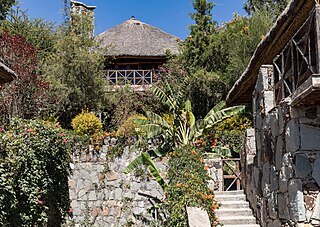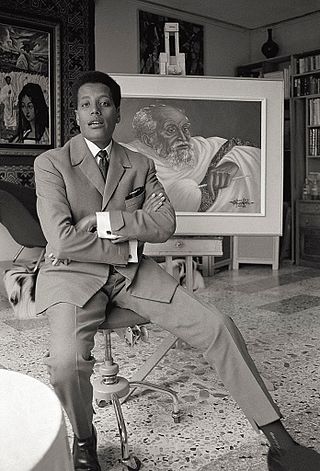
The politics of Ethiopia are the activities associated with the governance of Ethiopia. The government is structured as a federal parliamentary republic with both a President and Prime Minister. The government is multicameralism with a house of representative and a council. The term politics of Ethiopia mainly relates to the political activities in Ethiopia after the late 20th century when the democratization took place in the nation. The current political structure of Ethiopia was formed after the Tigrayan People's Liberation Front (TPLF) overthrew dictator President Mengistu Haile Mariam in 1991. General election was held in June 1994 and Ethiopia has maintained a multiparty political environment till today.

Addis Ababa is the capital and largest city of Ethiopia. In the 2007 census, the city's population was estimated to be 2,739,551 inhabitants. Addis Ababa is a highly developed and important cultural, artistic, financial and administrative centre of Ethiopia.

Oromia is a regional state in Ethiopia and the homeland of the Oromo people. The capital of Oromia is Addis Ababa.

Ambo is a town in west-central Ethiopia. Located in the West Shewa Zone of Oromia Region, west of Addis Ababa. And it is the capital city of West Shewa zone. This town has a latitude and longitude of 8°59′N37°51′E and an elevation of 2,101 meters.

Bishoftu is a town in central Ethiopia. Located in the East Shewa Zone of the Oromia Region, it sits at an elevation of 1,920 metres. It was formerly known as Debre Zeyit however since the late 1990s it has been officially known by the Oromo name, Bishoftu from bishaanooftuu, which was its name until 1955. The town serves as the primary airbase of the Ethiopian Air Force.

Afewerk Tekle was an Ethiopian artist, particularly known for his paintings on African and Christian themes as well as his stained glass.

Aïda Muluneh is an Ethiopian photographer and contemporary artist based in Addis Ababa. She does commercial work as well as photojournalism in Addis Ababa and elsewhere.
Ali Mohammed Musa, known professionally as Ali Birra, was an Ethiopian singer. He was regarded as the most popular Oromo icon, as well as an influential artist in the other regions and urban areas of Ethiopia. He had played a lot of songs in Amharic, Afar, Arabic and Somali languages. Ali was a celebrated as a poet and multi-instrumentalist.
Michael Tsegaye is an Ethiopian artist and photographer. Much of his work presents a glimpse of life in contemporary Ethiopia, although an extended catalogue of his images come from his travels abroad.
The Mecha and Tulema Self-Help Association was an Oromo political and freedom social movement in Ethiopia. The movement was primarily based in Bale, but was active in other regions as well. The organization was accused of committing acts of terror by the Ethiopian government, in hopes of suppressing the Oromo National Movement that was developing at the time. The Association was established by Oromo nationalists like Mamo Mezemer, Haile Mariam Gemeda and Alemu Kitessa.
Abel Tilahun is an Ethiopian-born artist who works across traditional and emerging art forms. At the heart of his work is a concern for both the cutting edge and the long arc of history.

'Kaliti Prison is a maximum security prison in Addis Ababa, Ethiopia. Commonly referred to as a gulag, it serves as the main prison of the country. It is 11 km south of central Addis Ababa, in Akaky Kaliti, the southernmost subcity of the nation's capital.
Klaus Mertens is a German contemporary artist. He is currently residing in Berlin and Addis Ababa.

The 2014–2016 Oromo protests were a series of protests and resistance first sparked on 25 April 2014. The initial actions were taken in opposition to the Addis Ababa Master Plan, and resumed on 12 November 2015 by university students and farmers in the town of Ginchi, located 80 km southwest of Addis Ababa, encircled by the Oromia region. The plan was to expand the capital into the Oromia special zone, leading to fears that native Oromo farmers would lose their land and be displaced. The plan was later dropped but protests continued, highlighting issues such as marginalization and human rights. Mulatu Gemechu, deputy chairman of the opposition Oromo Federalist Congress, expressed to Reuters: "so far, we have compiled a list of 33 protesters killed by armed security forces that included police and soldiers but I am very sure the list will grow". Protesters demanded social and political reforms, including an end to human rights abuses like government killings of civilians, mass arrests, government land seizures, and political marginalization of opposition groups. The government responded by restricting access to the internet and attacking as well as arresting protesters.

The Oromo conflict is a protracted conflict between the Oromo Liberation Front (OLF) and the Ethiopian government. The Oromo Liberation Front formed to fight the Ethiopian Empire to liberate the Oromo people and establish an independent state of Oromia. The conflict began in 1973, when Oromo nationalists established the OLF and its armed wing, the Oromo Liberation Army (OLA). These groups formed in response to prejudice against the Oromo people during the Haile Selassie and Derg era, when their language was banned from public administration, courts, church and schools, and the stereotype of Oromo people as a hindrance to expanding Ethiopian national identity.
Burayu is a town and woreda in Oromia Region, Ethiopia, located in the Oromia Special Zone Surrounding Finfinne in the Oromia Region, directly adjacent to the Oromo and national capital Addis Ababa. With the growth of the capital in recent decades and urban sprawl, the town has faced considerable economic and demographic pressures; its population leapt from around 10,000 in 1994 to an estimated 150,000 two decades later, as people, including many from the Southern Nations, Nationalities, and Peoples' Region, migrated from the countryside looking for work, and residents of Addis Ababa pushed outwards seeking cheaper housing.
The Burayu massacre was a series of communal clashes which occurred in the vicinity of the Ethiopian town of Burayu, in the Oromia Region, on 14–16 September 2018. Individuals from the Oromo and Dorze ethnicities fought in and around Burayu, a town in Oromia Region which is located near the northwest boundary of Addis Ababa, the federal capital. Different sources cite number of civilians killed both from Oromo and non-Oromo ethnicity.

Hachalu Hundessa was an Ethiopian singer, songwriter, and civil rights activist. Hachalu played a significant role in the 2014–2016 Oromo protests that led to Abiy Ahmed taking charge of the Oromo Democratic Party and Ethiopian People's Revolutionary Democratic Front, and subsequently becoming prime minister of Ethiopia in 2018.

The Hachalu Hundessa riots were a series of civil unrest that occurred in the Oromia Region of Ethiopia, more specifically in the hot spot of Addis Ababa, Shashamene and Ambo following the killing of the Oromo musician Hachalu Hundessa on 29 June 2020. The riots lead to the deaths of at least 239 people according to initial police reports. Peaceful protests against Hachalu's killing have been held by Oromos abroad as well. The Ethiopian Human Rights Commission (EHRC) found in its 1 January 2021 full report that part of the killings were a crime against humanity, with deliberate, widespread systematic killing of civilians by organised groups. The EHRC counted 123 deaths, 76 of which it attributed to security forces.

The Amhara genocide is an ongoing and systematic massacre of ethnic Amhara and Agew people in Ethiopia since 1990. Large-scale killings and grave human rights violations followed the implementation of the ethnic-federalist system in the country. In most of the cases, the mass murders were silent with perpetrators from various ethno-militant groups— from TPLF/TDF, OLF–OLA, and Gumuz armed groups.












